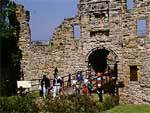 In
St
Andrews on the A91. Tel: 01334 477196 In
St
Andrews on the A91. Tel: 01334 477196
The castle of the Archbishops of St
Andrews. See the fascinating mine and counter-mine - rare examples of
medieval siege techniques - and the bottle dungeon hollowed out of solid
rock - from which death was the only release. A fascinating exhibition
in the visitor centre brings the history of the castle to life.
The main residence of the bishops of St
Andrews there has been a castle on this site since the 12th century. The
first castle was designed by Bishop Roger.
In 1296 the castle fell into English
hands and in 1303 was made ready to receive the English King. After
Bannockburn in 1314 the castle was retaken and repaired by Bishop
William Lamberton.
However, by the 1330ís it was once more
in English hands. In 1337 Sir Andrew Moray, Regent of Scotland,
recaptured the castle after a siege lasting three weeks. The castle was
then destroyed to prevent it falling into English hands.
Towards the end of the fourteenth century
Bishop Walter Trail ordered that the castle be rebuilt this was to be
the basis of all further development of the castle.
As the castle was the residence of the
most powerful church leaders in the land it seen many important visitors
among these was James I who received part of his education from Bishop
Henry Wardlaw, who was later to found Scotlandís first University in
1410.
It was also used as a state prison, with
notable inmatesí being David Duke of Rothesay, Duke Murdoch and St
Andrews first Archbishop, Patrick Graham.
In 1521 James Beaton set about
re-fortifying the castle to withstand artillery attack. In 1537 James
Beaton appointed his nephew David as his successor and in 1538 he became
Archbishop of St Andrews and a Cardinal of the Church.
In March 1546 David Beaton burnt the
Protestant preacher George Wishart in front of the castle walls. He made
many enemies and in may of 1546 he was murdered by a group of Fife
Lairds. Before his murder he had ordered that the castle be once again
strengthened with the main entrance being moved from the fore tower to
the south front.
After his murder the Earl of Arran
ordered that the castle be sieged. Nevertheless there was an armistice
which allowed the Protestant reformer John Knox the freedom to enter the
castle. The armistice was broken when a French fleet arrived and started
bombarding the castle they were joined by guns firing from the towers
off St Salvatorís and the Cathedral.
The defeated garrison including John Knox
were condemned to the Galleys.
Cardinal Beaton was succeeded by
Archbishop Hamilton who put right the damage caused by the siege of
1547.
After the reformation of the Scottish
Church the castle became increasingly neglected and fell into disrepair. |
